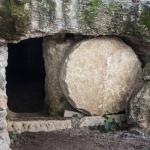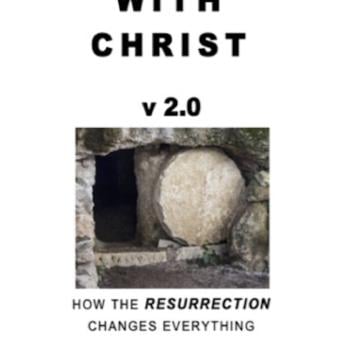
The most important question we will ever ask is “Did Jesus really rise from the dead?” The church did not create the resurrection stories; instead the resurrection stories created the church.
If Christ has not been raised, your faith is futile and you are still in your sins. 1 CORINTHIANS 15:17
This third revised chapter of my book Raised With Christ gets to the heart of the most important question we will ever ask: did Jesus truly rise from the dead and ascend to heaven? The very credibility of Jesus and his church hinges solely on how we answer this question. We will outline the historical evidence that Jesus lived, died by crucifixion, and yet his disciples were transformed into bold proclaimers of His resurrection, and that Christianity spread rapidly. We will look at various alternative theories to the reality of resurrection. We will see that the evidence overwhelmingly points to the reality of Jesus’ resurrection, and through the ages countless lives have been transformed by encountering the risen Christ. How will you answer the most important question you will ever be asked? For myself, I have concluded that the church did not create the resurrection stories; instead the resurrection stories created the church.
John MacArthur explained:
Neutrality is not an option. Either Jesus rose and rightly demands your attention, repentance, trust and obedience, or he stayed dead. If he only became a rotting corpse why should you follow him?[1]
Jesus predicted his resurrection repeatedly. Was he a liar, misleading his followers deliberately to think that he was divine? Could he have been that evil? Could the man whose teaching has never been surpassed also be a con man on such a massive scale? How likely is it that instead he was a deluded fool who falsely believed death could not hold him? Jesus’ credibility is destroyed if he did not rise from the dead. You cannot believe in him as a savior or a good teacher if he deceived us or was himself deceived so completely about something so fundamental. Either he rose and is therefore divine, or he did not, in which case he is no savior, and certainly not God. God is immortal and is not rotting in a tomb somewhere in Judea.
Gary Habermas[2] reports that there is now a remarkable degree of agreement among ancient historians irrespective of their beliefs about Jesus’ resurrection:
At least twelve separate facts are considered to be knowable history. (1) Jesus died by crucifixion and (2) was buried. (3) Jesus’ death caused the disciples to despair and lose hope, believing that his life was ended. (4) Although not as widely accepted, many scholars hold that the tomb in which Jesus was buried was discovered to be empty just a few days later. Critical scholars further agree that (5) the disciples had experiences which they believed were literal appearances of the risen Jesus. Because of these experiences, (6) the disciples were transformed from doubters who were afraid to identify themselves with Jesus to bold proclaimers of his death and resurrection. (7) This message was the center of preaching in the early church and (8) was especially proclaimed in Jerusalem, where Jesus died and was buried shortly before. As a result of this preaching, (9) the church was born and grew,
(10) with Sunday as the primary day of worship. (11) James, who had been a skeptic, was converted to the faith when he also believed that he saw the resurrected Jesus. (12) A few years later, Paul was converted by an experience which he, likewise, believed to be an appearance of the risen Jesus.[3]
Some of these events may seem implausible, but the very early reports of them are historically accepted facts. Seemingly improbable things do happen, even if they are above our human comprehension. Sir Arthur Conan Doyle suggested the following approach to investigation, putting these words into the mouth of fictional detective Sherlock Holmes:
“When you have eliminated the impossible, whatever remains, however improbable, must be the truth.”[4]
One by one we will consider all the possible explanations which could make sense of the documented historical facts.[5]
IS THE RESURRECTION JUST A MYTH OR A LEGEND?
It was once popular to argue that the stories of an empty tomb arose long after the life of Jesus, prompted by a supposedly fertile ground of other ancient mythology about resurrection. We now know that resurrection was not commonly believed possible, even in the realm of mythology. Some people outside of Judaism did believe in the survival of the soul after death, but not in a bodily resurrection. The news of Jesus’ resurrection had to conquer this skepticism. The Jews did not believe that the prophecies concerning the suffering servant referred to the same person as the Messiah. It is only in the light of Jesus’ death and victorious resurrection that we see these two figures as the same person.[6]
N.T. Wright[7] has carefully studied all the historical evidence and concludes,
“Christianity was born into a world where its central claim was known to be false. Many believed that the dead were non-existent; outside Judaism, nobody believed in resurrection.”[8]
Wright also demonstrates that it is only after the events of Jesus’ life, death, and resurrection had been taught throughout the Roman Empire that other stories of resurrection began to arise in popular culture. Far from being involved in producing the New Testament stories, these myths may well have instead been prompted by accounts of Jesus’ resurrection.
It is hard to imagine any group creating a resurrection story within a few years of the death of their founder. Scholars today agree that the Gospels were written within the lifespan of people who had met Jesus. If these stories had been made up within decades after the death of Jesus, others would have been able to immediately disprove them and stop them from spreading.
If the accounts of the resurrection were a late addition to Christianity, then an early form, which did not believe in the resurrection of Jesus, would have left traces in the historical record. There are no such traces of early Christians who denied the resurrection. Only in 1 Corinthians 15 does Paul defend against the charge that Jesus did not rise. Even there Paul does not attempt to prove the resurrection of Jesus; he instead assumes his readers all believe it and uses that to prove our resurrection (see 1 Corinthians 15:12–17).
The early Christians, according to the historical records available to us, all believed in the resurrection of Jesus. Such a belief, for it to be so widespread, must have arisen very early. In all the arguments about doctrine that arose over the next few hundred years, doubts about the bodily resurrection of Jesus did not feature. True Christianity does not exist without a belief in Jesus’ resurrection.
Throughout the New Testament the resurrection of Jesus is assumed. Paul repeatedly prays for grace and peace “from God our Father and the Lord Jesus Christ.”[9] For Jesus to be able to grant anything, he must still be alive. Similarly Paul frequently refers to himself as “an apostle of Christ Jesus.”[10] An apostle is a messenger or representative and is not sent by a dead man. Certainly Paul was not appointed before Christ’s death. The opening chapter of each of Paul’s letters therefore has at least one mention of Jesus in such a way that it requires he is still alive.
Throughout these letters, Paul often mentions that God raised Jesus from the dead.[11] Jesus is referred to constantly as a living and active presence without Paul needing to elaborate on or argue for the resurrection. When an event is part of the very foundations of a group, it can be mentioned without explanation, knowing that the hearers will understand.
The Gospel resurrection stories do not reflect upon the events theologically. If they were late myths, we could expect them to be at least as reflective as Paul’s writings in 1 Corinthians, if not more so. Why do the gospel writers not even make the deduction that Jesus’ resurrection guarantees our own? The accounts come across as basic eyewitness reports given by those who did not yet fully understand the significance of what they had seen and heard.
Christianity is a simple faith that has no worthwhile content if the resurrection is not true, as Paul argues strongly in 1 Corinthians 15. Few historians doubt that the church was founded on a belief that Jesus had literally risen from the dead. Any contrary theory needs to explain how a small group of Jews became passionately convinced of the truth of the resurrection and spread it rapidly across the Middle East and into Europe. Within a couple of centuries this novel faith had conquered the then known world without a sword being drawn.
The church did not create the resurrection stories; instead the resurrection stories created the church.
DID THE DISCIPLES SIMPLY LIE?
All of the problems facing the idea that the resurrection stories were late myths apply even more strongly to the suggestion that the disciples knowingly spread a lie. Almost all of the disciples are believed to have been executed because of their refusal to deny that Jesus rose again. People do die all the time for falsehoods that they themselves genuinely believe to be true. It is, however, impossible to believe that all of them would die for something they knew to be a deliberate deception. In addition, anyone who could prove that the disciples’ story was untrue would have severely hampered the growth of the church. Spurgeon demolishes this idea of lying disciples with typical clarity:
The resurrection of Jesus Christ from the dead is one of the best attested facts on record. There were so many witnesses to behold it, that if we do in the least degree receive the credibility of men’s testimonies, we cannot and we dare not doubt that Jesus rose from the dead . . . these persons could not every one of them have been so positively deceived as to say that they had seen this man . . . they could not all, surely, have agreed together to help on this imposture: if they did, it is the most marvelous thing we have on record, that not one of them ever broke faith with the others. . . . They were men who had nothing to gain by it; they subjected themselves to persecution by affirming the very fact; they were ready to die for it, and did die for it. . . . How, then, dare any man say that the Christian religion is not true, when we know for a certainty that Christ died and rose again from the dead? And knowing that, who shall deny the divinity of the Savior? Who shall say that he is not mighty to save? Our faith hath a solid basis, for it hath all these witnesses on which to rest, and the more sure witness of the Holy Spirit witnessing in our hearts.[12]
Spurgeon also reminds us that the work of the Spirit in us is more important in causing us to believe than rational arguments. Today a purely intellectual approach to faith has infiltrated the church. Spurgeon, however, does not encourage us to park our brains nor to discard our Bibles. This quote is a helpful pointer to a different way. We are urged to consider the facts and look to a form of persuasion directly from the Spirit himself. This might surprise some, but it is true nonetheless. As we continue to look at the logical reasons for our belief in the resurrection, let’s pause for a moment and pray that God will grant us ever-increasing faith.
DID THE DISCIPLES STEAL THE BODY?
This theory at least has the benefit of an early origin. It was the primary explanation circulating during the decades after Jesus’ life and is the only suggestion rebutted in the New Testament. Matthew reports that the story had its origin in a conversation held between the guards and the Jewish authorities. When the guards reported the empty tomb, they were ordered,
“Tell the people, ‘His disciples came by night and stole him away while we were asleep.’ And if this comes to the governor’s ears, we will satisfy him and keep you out of trouble” (Matthew 28:13–14).
Without the intervention of the leaders, these Roman soldiers would have faced a certain death penalty for grossly neglecting their duty. It seems impossible that an elite group of soldiers would have been this careless. Also, even if they were asleep, how could they have known exactly who stole the body?
Finally, what possible motive would drive the followers of a failed messiah to rob a grave and go to their own graves for propagating the lie that he was the risen Lord of Glory? This theory hasn’t gained much favor. It is also implausible that anyone else would have stolen the body because the only thing of value (the graveclothes) was left behind. We will not explore in this book whether the Turin Shroud is actually the graveclothes of Jesus, though this does make for some fascinating research.
DID THE AUTHORITIES HIDE THE BODY?
The Christian faith was rightly perceived as a threat by both the Jews, whose monotheism did not fit well with the idea of worshipping a dead man, and the Romans, who proclaimed that Caesar, and not Jesus, was the “son of god” and to be worshipped. As strange as it must have seemed when the empty tomb was discovered, in a remarkably short course of time Christianity would succeed in overthrowing the worship of the emperor. Nothing less than a revolution began on that first Easter Sunday.
If the authorities had possession of the body, it is obvious that they would have taken the earliest possible opportunity to display it and thereby destroy this dangerous new faith at its inception. Jesus’ disciples were boldly declaring the resurrection of Jesus, and many people were now turning to this new faith. If it were possible to easily prove that Jesus was still dead, the Romans or the Jewish authorities would have immediately done so and the new religion would have been quashed. Even if the authorities had somehow disposed of the body and so could not display it, they could have easily cleared up the whole misunderstanding by informing the public. But there is no record of this happening.
DID THEY GO TO THE WRONG TOMB?
It is impossible that the disciples, the women, the guards, the authorities, and Joseph of Arimathea would all forget where Jesus’ tomb was. If anyone remembered, it would have been very easy to halt the church’s growth before it even started by publicizing where the tomb was and even putting on a show of the slowly decomposing body.
DID JESUS ONLY SWOON ON THE CROSS?
Surprisingly many people have argued that Jesus never actually died on the cross. Theories of a substitution by another man or a faint or a near-death experience on the cross abound, but the historical account is unequivocal regarding the death of Jesus.
One reason for the popularity of this view is that some Muslims teach it based on the following verse in the Qur’an:
“That they said (in boast), “We killed Christ Jesus the son of Mary, the Apostle of Allah”;- but they killed him not, nor crucified him, but so it was made to appear to them, and those who differ therein are full of doubts, with no (certain) knowledge, but only conjecture to follow, for of a surety they killed him not:-Nay, Allah raised him up unto Himself; and Allah is Exalted in Power, Wise” (Surah 4:157-158)
However, the idea that Jesus did not die seems somewhat implausible to most who have examined the historical evidence. Dan Story, an apologist who has written more than fifteen books, said:
There is not a shred of evidence to support this theory. Nowhere in Roman or Jewish history does anyone argue or even imply that Jesus did not die on the cross. It took eighteen centuries after Christ’s death before this idea found an advocate. The fact is that the historical record refutes this theory at every turn.[13]
Jesus endured a relentless night of several trials and then he was brutally beaten and whipped. It was well known that Roman’s often whipped their victims so badly that they died even before being crucified. Before even being hung on the cross he would have been utterly depleted. Jesus was then subjected to crucifixion, and a group of professional executioners confirmed he was dead. To be absolutely certain, a spear was thrust into his side, causing a flow of blood and water, which demonstrated his heart sac had burst. Following all this, he was also wrapped in approximately one hundred pounds of linens and spices, so even if he had somehow miraculously survived the ordeal of the cross, he would likely have been suffocated. If he was still somehow alive in the tomb he had no food, no water, and no medical care. Surely that spell in the tomb would have killed him, even if he had not endured such extensive trauma. In essence, the evidence is overwhelming: Jesus definitely died. [14]
Let’s just suppose for a moment that Jesus had somehow been alive in the tomb. He would have somehow had to summon a convenient earthquake, push back the stone, fight off the soldiers who were guarding him, and then convince his disciples he was the resurrected King. His wounds and his general state of health would have made him a source of horror, not faith!
There is a further practical problem with the swoon theory. In order to breathe while nailed to a cross, you have to visibly move your body and undergo excruciating pain. To fake death on the cross and still breathe without this being noticed would be physically impossible:
Adequate exhalation required lifting the body by pushing up on the feet and by flexing the elbows. . . . However, this would place the entire weight of the body on the tarsals and would produce searing pain. Furthermore, flexion of the elbows would cause rotation of the wrists about the iron nails and cause fiery pain along the damaged median nerves. . . . Muscle cramps and paresthesias of the outstretched and uplifted arms would add to the discomfort. As a result, each respiratory effort would become agonizing and tiring and lead eventually to asphyxia.[15]
Thus without this physical exertion, which would be obvious to any observer, the victim would die very quickly, thus making it impossible to fake their death. Soldiers would often break people’s legs to speed up their death.
This swoon theory has become surprisingly popular in recent years, despite its total lack of historical plausibility.
DID THE DISCIPLES SEE HALLUCINATIONS?
George Ladd said, “The empty tomb of itself did not create faith in the resurrection.”[16] It was only the appearances of Jesus that allowed the radical conclusion that Jesus had risen again to an eternal life. Many a skeptic will argue that the resurrection appearances of Jesus were simply a phenomenon of vulnerable people seeing what they wanted to see. Newly bereaved people frequently experience hallucinations of their loved ones.
Having worked as a psychiatrist and having spoken to many people with hallucinations, I can confirm that nothing about these appearances of Jesus sounds similar to either the “normal” experiences of the recently bereaved or the troubling waking nightmares of the mentally ill.
It is extremely rare for any hallucination to be shared by two people. I have certainly never heard of any case of a larger group of twelve, let alone five hundred, sharing the same such experience. Hallucinations tend to be fleeting and of an otherworldly nature. The Gospel writers took great pains to report concrete facts—for example, that Jesus had a physical body that could eat and drink and that they could touch.
Hallucinations are not usually associated with a positive and persistent life transformation. They tend to weaken someone’s mental well-being. These so-called “hallucinations” drove away the fear and despondency of the disciples and gave boldness to preach their new gospel throughout the Roman Empire at great risk to their own lives. This is completely inconsistent with the results of hallucinations as described in any medical textbook, or in any case I came across during my career.
Additionally, many post-resurrection converts to the faith had not previously believed that Jesus was the Son of God. Jesus’ brothers and mother were skeptical of his claims during his life and yet became members of his church, proclaiming the resurrection. They, like the arch-persecutor Saul (also known as Paul), were not prepared for such an experience.
Paul’s case is particularly compelling. Philippians 3 shows us that his persecution of Christians was motivated out of religious sincerity. He believed that they were blaspheming the one true God and that he had a commission to wipe them out. The disciples’ teaching from the Old Testament did not convince him. The miracles they performed were not persuasive. He may well have heard Jesus preaching in the flesh, but if so, that did not convince him[17]. His passionate response to the new sect has always made me think he must have met Jesus during his life. As a young, smart Pharisee being trained in Jerusalem under Gamaliel (Acts 22:3), he would have been very likely to be part of the groups of Pharisees sent to check out Jesus. Some of Luke’s material about the Pharisees may have come from Paul himself as eyewitness reports. Paul speaks of previously regarding Christ “according to the flesh” (2 Corinthians 5:16).
On the road to Damascus Paul met the risen Jesus in a dramatic, life changing revelation. Only that encounter can explain his radical transformation. He realized he had been wrong and that Jesus had risen and that God was therefore on the side of the Christians. He had been opposing Christ himself!
Whatever explanations we offer for the events of the Gospels and Acts must explain both the empty tomb and the appearances of Jesus. It simply will not do to dismiss these appearances without explaining how the tomb came to be empty. No other newly departed well-known leader, no matter how much loved by his followers, has ever appeared to them for several weeks after his death and somehow convinced them that, far from being a spirit, he had risen from the dead. Jesus is undeniably unique in this regard.
OTHER HISTORICAL EVIDENCE FOR THE RESURRECTION
We will now look at a few examples[18] of other historical evidence for the resurrection of Jesus. Roman administrator Pliny wrote around a.d. 112 about the Christians in his area whom he was persecuting as they had become very numerous:
They [the Christians] were in the habit of meeting on a certain fixed day before it was light, when they sang in alternate verses a hymn to Christ, as to a god, and bound themselves by a solemn oath, not to any wicked deeds, but never to commit any fraud, theft or adultery, never to falsify their word, nor deny a trust when they should be called upon to deliver it up; after which it was their custom to separate, and then reassemble to partake of food—but food of an ordinary and innocent kind.[19]
The worship of Jesus as “a god” by people raised as Jews would only be possible if he had risen from the dead. Their early-morning meetings on a fixed day (likely the first day of the week, Sunday) seemed to be timed to celebrate his resurrection.
A remarkable inscription of a direct order from the Roman emperor was uncovered in Nazareth. Dated between a.d. 40 and 50 it reads:
Ordinance of Caesar. It is my pleasure that graves and tombs remain perpetually undisturbed for those who have made them for the cult of their ancestors or children or members of their house. If, however, anyone charges that another has either demolished them, or has in any other way extracted the buried, or has maliciously transferred them to other places in order to wrong them, or has displaced the sealing on other stones, against such a one I order that a trial be instituted, as in respect of the gods, so in regard to the cult of mortals. For it shall be much more obligatory to honor the buried. Let it be absolutely forbidden for anyone to disturb them. In case of violation I desire that the offender be sentenced to capital punishment on charge of violation of sepulcher.[20]
That this should be found in Nazareth, and with such an unusually severe penalty, suggests to many scholars that it had been prompted by news of the claim that Jesus had risen from the dead and the counterclaim that the body had been stolen. This order would then be a form of attempting to lock the stable door after the horse has bolted.
An early Christian apologist, Justin Martyr, wrote an open letter to the Roman emperor, soon after a.d. 150, claiming that at the time the emperor could find information about the birth of Jesus from the records of a census and his life, miracles, raising the dead, and the reports of his own resurrection from official reports filed by Pilate. He wrote a similar letter to the Jews, claiming that far from accepting their Messiah, they had appointed teachers to spread the lie that the disciples had stolen his body. He could never have written in such a way if the recipients of his letter could easily disprove such claims. The fact that Pilate’s reports have not survived does not discredit this letter, as opponents of Christianity did not contradict Martyr at the time. His work would never have become as popular as it was at the time if it contained blatant lies.[21]
The testimony of enemies is sometimes the most compelling. Around a.d. 175 Celsus wrote The True Word, the first critique of Christianity, and tried to discredit the resurrection as being witnessed by “a hysterical female,”[22] which itself demonstrates that the Gospels represent what was being widely discussed at the time.
A Jewish document written around a.d. 600 but claimed to be based on older sources has the following account for why Jesus’ body had disappeared from the tomb. This account does not ring true, but it does provide further evidence of a persistent rumor from the Jews that the disciples stole the body:
The disciples came to the original tomb, found Jesus’ body gone and proclaimed him risen. The Jewish leaders also proceeded to Joseph’s tomb and found it empty. Juda then took them to his grave and dug up the body of Jesus. The Jewish leaders were greatly relieved and wanted to take the body. Juda replied that he would sell them the body of Jesus and did so for thirty pieces of silver. The Jewish priests then dragged Jesus’ body through the streets of Jerusalem.[23]
There is simply no record of any significant group of early Christians who doubted that Jesus had risen from the dead. The early existence of a group of people who believed Christ had risen from the dead is confirmed by multiple secular sources. Many secular historians have concurred that the evidence is exceptionally good that Jesus existed, was killed, and that his followers claimed he had risen from the dead.
The evidence for the rapid expansion of the church is compelling. No other successful movement has ever claimed its founder rose from the dead. Ultimately, the persistence and growth throughout history of the largest movement the world has ever seen is the strongest evidence for the resurrection. Many millions of people have claimed that their lives have been transformed by Jesus and that they had a relationship with Jesus. Even today, testimonies of lives that have been changed continue to flabbergast the skeptic and give more faith to the believer. According to Robert Stein:[24]
[Another] witness to the resurrection is the existential experience of the risen Christ in the heart of the believer. As one familiar hymn states it, “You ask me how I know He lives? He lives within my heart.” To those who would minimize this argument and reject it as unscientific and subjective, the evangelical would point out that millions of Christians have for nearly two thousand years made this very claim. It is a simple fact that throughout the history of the church, the single most important witness to the resurrection of Jesus has been the witness of the risen Christ within the heart of the believer![25]
Many Christians today from all backgrounds are embarrassed by such a statement and do not seek or value such an experience. I fear that all wings of the church today are weaker for this lack. William Barclay stressed our need to be aware of the personal presence of our Lord Jesus:
Jesus is not a figure in a book but a living presence. It is not enough to study the story of Jesus like the life of any other great historical figure. We may begin that way but we must end by meeting him. Jesus is not a memory but a presence. . . . Jesus is not someone to discuss so much as someone to meet. The Christian life is not the life of a man who knows about Jesus, but the life of a man who knows Jesus. . . . The greatest scholar in the world who knows everything about Jesus is less than the humblest Christian who knows him.[26]
CONCLUSION
We have examined the Gospel accounts of the resurrection, and have considered all possible explanations, and conclude that the only realistic interpretation of the first Easter is that Jesus did rise from the dead. Habermas reports that, even by critical scholars who are not Christians, it is now largely accepted that no other explanation really makes sense:
Alternative hypotheses that seek to explain away the resurrection in natural terms have failed to adequately account for the known historical facts. Not only is this conclusion dictated by the data themselves, but critical scholars have even admitted this failure. Few researchers have favored any of these [theories] in recent times.[27]
After a lifetime of serious scholarly study, N. T. Wright concludes, “The only possible reason why early Christianity began and took the shape that it did is that the tomb really was empty and that people really did meet Jesus, alive again.”[28]
N.T. Wright counters six conclusions that liberal scholars have come to about the resurrection of Jesus. I will conclude by simply stating the reverse of these liberal statements. Thanks to the work of scholars of the resurrection we now know that:
- In ancient times both the Jews and Greeks had a clear understanding that resurrection meant a restoration of physical life after death. Greeks believed this was impossible. Some Jews had a belief in bodily resurrection at the end of the age.
- The earliest Christian writer, Paul, clearly believed in a physical, bodily resurrection both of Jesus and in the future for believers.
- From the earliest times, Christians believed in an empty tomb and a bodily resurrection of a Jesus who could be seen and touched rather than in some kind of “spiritual” glorification.
- The resurrection stories of the Gospels are early, credible, consistent, eyewitness-based accounts that are clearly intended to describe literal historical events.
- The accounts of the appearances of the risen Jesus cannot be explained as some kind of fantasy, hallucination, or “spiritual experience” without any external reality.
- Jesus’ body was really dead, not comatose; it was truly buried, and it actually left behind an empty tomb that had been guarded by soldiers. His tomb really is now as empty as the cross is.[29]
Wright concluded that the empty tomb and the reports of appearances of the risen Jesus are “in the same sort of category, of historical probability so high as to be virtually certain, as the death of Augustus in AD 14 or the fall of Jerusalem in AD 70.”[30]
As amazing as a belief in the resurrection is, and as terrifying as its implications are, this has always been the most reliable identifying mark of movements that call themselves Christian. It is the fundamental basis of Christianity. Astonishingly, as we will see in the next chapter, the resurrection is so familiar to us it can often be simply assumed and even neglected. Yet Paul makes accepting this glorious truth the touchstone of true Christian faith:
If you confess with your mouth that Jesus is Lord and believe in your heart that God raised him from the dead, you will be saved. (Romans 10:9)
REFERENCES ARE FOUND AT THE BOTTOM OF THIS PAGE
Raised With Christ would never have been possible without heavy use of Logos Bible Software. If you do not yet have this wonderful Bible Study tool or you are due an upgrade, readers of this blog get a 10% discount.
READ MORE
Chapter Four:
REFERENCES
[1]John MacArthur’s Preface, in Gerard Chrispin, The Resurrection: The Unopened Gift (Epsom, UK: Day One, 2002), 16.
[2]Professor of Apologetics and Philosophy at Liberty University and one of the world’s foremost scholars of the resurrection.
[3]Gary Habermas, The Historical Jesus (Joplin, MO: College Press: 1996), 158.
[4]Arthur Conan Doyle, Sign of Four (London: Penguin Classics, 2001), 42.
[5]This is, of course, a well-worn path by apologists, and I acknowledge the influence of George Eldon Ladd, I Believe in the Resurrection of Jesus (London: Hodder and Stoughton, 1975); Gary Gromacki, “The Historicity of the Resurrection of Jesus Christ,” Journal of Ministry and Theology, 6:1, 63–88 and 6:2, 45–58 (Baptist Bible College and Seminary, 2002); the various works of Josh McDowell; Wilbur M. Smith, “The Need for a Vigorous Apologetic in the Present Battle for the Christian Faith: Part 2,” Bibliotheca Sacra, 100:532–545 (Dallas Theological Seminary, 1943); Dan Story, Defending Your Faith (Grand Rapids: Kregel, 1997), 87–98; and David MacLeod, “The Resurrection of Jesus Christ: Myth, Hoax, or History?,” Emmaus Journal, 157–199 (Emmaus Bible College, 1998), among others.
[6]See Ladd, I Believe in the Resurrection of Jesus, 36.
[7]Bishop of Durham and New Testament scholar whose book on the resurrection is widely recognized to be the definitive work on the subject.
[8]N. T. Wright, The Resurrection of the Son of God (London: SPCK, 2003), 35.
[9]Romans 1:7; 1 Corinthians 1:3; 2 Corinthians 1:2; Galatians 1:3; Ephesians 1:2; Philippians 1:2;
2 Thessalonians 1:2; 1 Timothy 1:2; 2 Timothy 1:2; Philemon 3; see also Titus 1:4.
[10]1 Corinthians 1:1; 2 Corinthians 1:1; Ephesians 1:1; Colossians 1:1; 1 Timothy 1:1; 2 Timothy 1:1.
[11]See, for example, Romans 4:24; 6:4; 6:9; 7:4; 8:11; 10:9; 1 Corinthians 15:12; 15:20; Galatians 1:1; Ephesians 1:20; Colossians 2:12; 1 Thessalonians 1:10.
[12]C. H. Spurgeon, Sermon No. 66, “The Resurrection of the Dead,” delivered on February 17, 1856, at New Park Street Chapel, Southwark; http://www.spurgeon.org/sermons/0066.htm.
[13]Story, Defending Your Faith, 93, emphasis added.
[14] The arguments in this paragraph were summarized in Mark Driscoll and Gerry Breshears, Vintage Jesus (Wheaton, IL: Crossway Books, 2007), 133.
[15]William D. Edwards, Wesley J. Gabel, and Floyd E. Hosmer, “On the Physical Death of Jesus Christ,” Journal of the American Medical Association, March 21, 1986, 255:1455–1463; http://jama.ama-assn.org/cgi/content/abstract/255/11/1455.
[16]Ladd, I Believe in the Resurrection of Jesus, 89.
[18]For more see, for example, Habermas, The Historical Jesus.
[19]Cited in ibid., 199.
[20]Cited in ibid., 176.
[21]See ibid., 235.
[22]Joel B. Green et al., Dictionary of Jesus and the Gospels (Downers Grove, IL: InterVarsity Press, 1992), 884.
[23]Habermas, The Historical Jesus, 205.
[24]Previous Professor of Divinity and Biblical Criticism at Glasgow University.
[25]Robert H. Stein, “Was the Tomb Really Empty?” Journal of the Evangelical Theological Society, 20:23–29 (The Evangelical Theological Society, 1977). Also reprinted in Themelios and available online at http://s3.amazonaws.com/tgc-documents/journal-issues/5.1_Stein.pdf.
[26]William Barclay, ed., The Gospel of Mark, The Daily Study Bible Series (Philadelphia: The Westminster Press, 2000), on Mark 16:9.
[27]Habermas, The Historical Jesus, 170.
[28]Wright, The Resurrection of the Son of God, 8.
[29]Adapted from ibid., 7.
[30]Ibid., 710.














